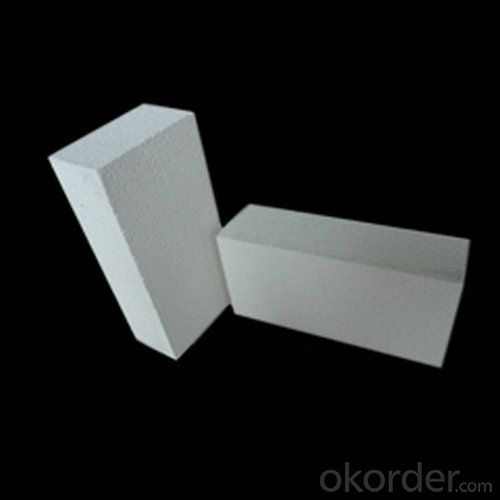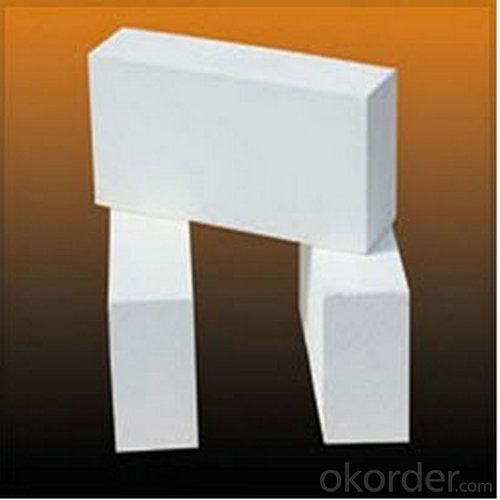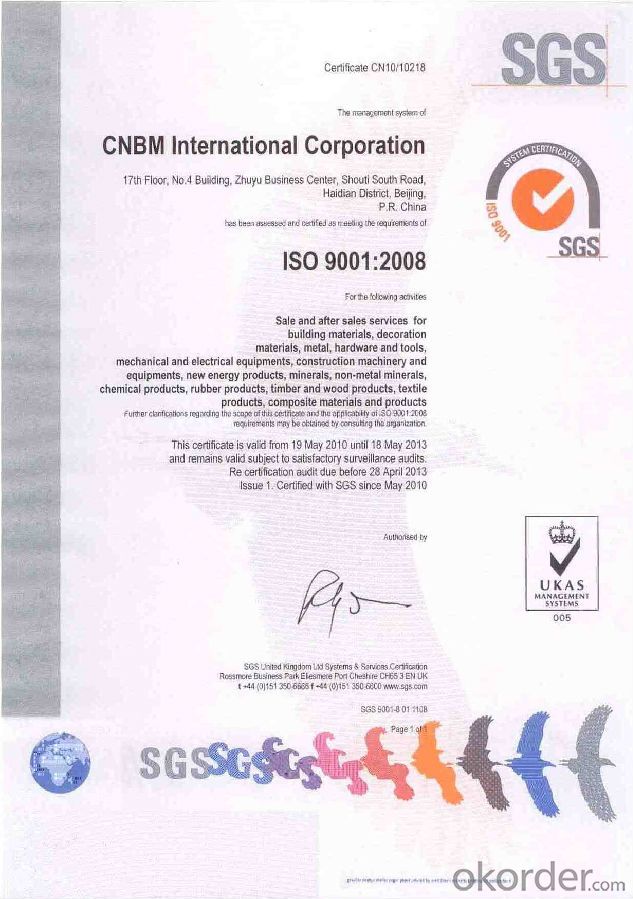Insulating Firebricks GJM23 for hHot Face Lining
- Loading Port:
- Tianjin
- Payment Terms:
- TT OR LC
- Min Order Qty:
- 1 m.t.
- Supply Capability:
- 20000 m.t./month
OKorder Service Pledge
OKorder Financial Service
You Might Also Like
General Information of Insulating Firebricks
CMAX insulating firebricks are classified under temperature between 1300℃ to 1700℃, manufactured from high purity alumina clay.
Feature of Insulating Firebricks
Light weight and low thermal conductivity
Low heat storage
Low iron and impurities
High thermal shock resistance
Application of Insulating Firebricks
CMAX insulating firebricks can be used as a hot face lining directly exposed to the heat or as a backup insulation layer in iron and steel mills, non-ferrous foundries, petrochemical, ceramic, glass.
Images of Insulating Firebricks


Technical Data of Insulating Firebricks
INSULATING FIRE BRICK---GJM23
Classification Temperature (℉/℃) 2300/1260
Bulk Density (g/cm3) ≤0.5
Thermal Conductivity
800℃, W/m.K ≤0.18
1000℃, W/m.K ≤0.20
Reheating Linear Change (%) 1230℃×12h
≤0.5
Chemical Composition (%)
Al2O3 ≥45
Fe2O3 ≤1.0
Company Introduction
Who CNBM is
CNBM is a Fortune 500 and a governmental owned National Building Material company in Beijing, China.
What CNBM Can Do
We can supply ALL KINDS OF REFRACTORIES BRICK/CASTABLE and CERAMIC FIBER PRODUCTS in high quality and competitive price.
What Certification CNBM Have

FAQ
If I need your offer, what information do you need?
In order to choose suitable products, it will be appreciated to provide us the information, such us specification, technical data, order quantity, products application etc.
If any question, please contact us freely.
How do you control the products quality?
With strict quality control system throughout the materials selection and production process, our refractory and ceramic fiber products quality is effectively controlled to meet customer requirements.
From the raw materials selecting, our quality control begin. The quality certificates of raw materials are required and each batch will be tested before using. During production, the quality control are conducted by workers and then each piece will be sorted and examined by quality supervisor.
I’m not satisfied with the refractory materials I used before, can you propose more suitable pro
Yes. Please give us the problems you faced, your requirements and the technical data of the products you used before. That we will give you our suggestion and propose the solution based on your special requirements.
What’s the lead time for my order?
It depends on customers’ requirements and our production schedule. And usually we need 30-60 days for refractory bricks,10-25 days for unshaped refractory materials and 10-20 days for ceramic fiber blankets.
Can you offer Door-to-Door delivery?
Yes, but only for some countries such us U.S., UAE, Saudi Arabia, Iran, and Russia, etc.
What is the minimum quantity?
There is no minimum order quantity. Depending on the item and processing, there may be a minimum production required, however we can offer a quotation based only on the quantity you need.
- Q:Do insulating fire bricks have a high thermal shock resistance?
- Insulating fire bricks are commonly known for their remarkable thermal shock resistance. They are specifically engineered to endure sudden temperature variations without any fractures or damage. Crafted from lightweight refractory materials with low thermal conductivity, these bricks effectively reduce heat transfer and prevent thermal strain. Furthermore, the firing process they undergo further enhances their ability to withstand thermal shocks. In summary, these bricks are perfect for situations where extreme temperature fluctuations are encountered, making them a dependable option for insulation in high-temperature surroundings.
- Q:Do insulating fire bricks require preheating before use?
- Yes, insulating fire bricks typically require preheating before use. Preheating the bricks helps to remove any moisture or volatile organic compounds that may be present in the material. This is important because moisture or volatile compounds can cause the bricks to crack or even explode when exposed to high temperatures. Preheating also helps to condition the bricks and prevent thermal shock, which can occur when the bricks are rapidly exposed to extreme temperatures. By slowly and gradually increasing the temperature, the bricks are able to expand and contract without any damage. Therefore, it is recommended to preheat insulating fire bricks before using them in order to ensure their durability and performance.
- Q:Can insulating fire bricks be used in copper smelting furnaces?
- Yes, insulating fire bricks can be used in copper smelting furnaces. These bricks are designed to withstand high temperatures and provide excellent insulation, making them suitable for use in copper smelting processes where heat retention and efficiency are important.
- Q:What is the bulk density of insulating bricks?
- National classification standard: water absorption rate of ceramic tile is less than or equal to 0.5%;
- Q:Do insulating fire bricks require any special installation techniques?
- Yes, insulating fire bricks do require special installation techniques. These bricks are designed to provide excellent thermal insulation, which means they need to be installed properly to achieve optimal performance. Firstly, it is important to ensure that the installation surface is clean and free from any debris or moisture. This helps to create a strong and stable base for the bricks. Next, a suitable refractory mortar or adhesive should be used to secure the bricks in place. This mortar should be specifically designed for high-temperature applications and should be able to withstand the thermal expansion and contraction that occurs during heating and cooling cycles. During the installation process, it is crucial to pay attention to the joints between the bricks. These joints should be properly filled with mortar to prevent heat loss and maintain the insulating properties of the bricks. Additionally, insulating fire bricks should be carefully stacked and aligned to ensure a tight fit and minimize any gaps between the bricks. This helps to maximize the insulating effect and prevent heat leakage. Finally, it is recommended to consult the manufacturer's guidelines and follow their recommended installation techniques. Each type of insulating fire brick may have specific requirements that need to be followed for proper installation. Overall, insulating fire bricks do require special installation techniques to ensure their effectiveness and longevity. Following proper installation practices will help to enhance the thermal insulation properties of these bricks and optimize their performance.
- Q:Can insulating fire bricks be used in the construction of coke ovens?
- The use of insulating fire bricks in the construction of coke ovens is indeed possible. These bricks are specifically designed to endure extreme temperatures and offer exceptional thermal insulation. Coke ovens, which typically operate at around 2000 degrees Fahrenheit, necessitate materials that can withstand such conditions. The low thermal conductivity of insulating fire bricks effectively hinders heat transfer between the interior and exterior of the oven. This feature helps to maintain the necessary high temperatures for coal carbonization in the coke oven, while simultaneously minimizing heat loss. Moreover, insulating fire bricks possess a lightweight composition and high strength, which makes them ideal for coke oven construction. Their lightweight nature facilitates easier installation and reduces the overall weight of the structure. Additionally, their high strength ensures that they can endure the harsh operating conditions of the coke oven without cracking or crumbling. In conclusion, insulating fire bricks are a suitable choice for constructing coke ovens due to their ability to withstand high temperatures, provide thermal insulation, and offer durability.
- Q:How do insulating fire bricks affect the overall energy consumption of a structure?
- Insulating fire bricks play a crucial role in reducing the overall energy consumption of a structure. These specialized bricks are designed to have low thermal conductivity, which means they are highly effective in preventing the transfer of heat. By installing insulating fire bricks in the walls, floors, and roofs of a building, the heat loss or gain through these surfaces can be significantly minimized. One of the major benefits of insulating fire bricks is their ability to enhance the thermal insulation of a structure. As heat tends to flow from hotter areas to cooler areas, buildings often experience heat loss during cold winters or heat gain during hot summers. Insulating fire bricks act as a barrier, limiting the transfer of heat through the building envelope. This insulation helps maintain a stable indoor temperature and reduces the need for excessive heating or cooling, thereby reducing energy consumption. Furthermore, insulating fire bricks also contribute to the overall energy efficiency of a structure by improving the performance of heating and cooling systems. Since these bricks minimize heat transfer, the heating system can operate more efficiently as it doesn't need to compensate for heat loss. Similarly, air conditioning systems can cool a building more effectively as the heat gain is reduced. This efficient operation of HVAC systems results in lower energy consumption and reduces the energy demand of the structure. Additionally, insulating fire bricks can also contribute to the overall sustainability of a structure. By reducing energy consumption, these bricks help lower the carbon footprint associated with the building. The use of less energy not only benefits the environment but also reduces utility bills for the occupants, making the structure more cost-effective in the long run. In conclusion, insulating fire bricks have a significant impact on the overall energy consumption of a structure. With their excellent thermal insulation properties, they reduce heat loss or gain through the building envelope, enhance the efficiency of heating and cooling systems, and contribute to the sustainability of the structure. By incorporating insulating fire bricks into the construction or renovation process, energy consumption can be effectively reduced, leading to a more energy-efficient and environmentally friendly building.
- Q:How do insulating fire bricks affect the overall weight of a structure?
- Insulating fire bricks can significantly affect the overall weight of a structure due to their lightweight nature. As the name suggests, these bricks are designed to have low density and high thermal resistance properties. Unlike traditional bricks or concrete blocks, insulating fire bricks are made from lightweight materials such as clay, silica, and aluminum oxide. Due to their reduced weight, using insulating fire bricks in construction can help reduce the overall load on a structure. This can be particularly advantageous in cases where weight restrictions or limitations are a concern, such as in high-rise buildings or areas with poor soil conditions. The lightweight nature of insulating fire bricks also allows for easier transportation, handling, and installation, making construction processes more efficient and cost-effective. Additionally, the reduced weight can minimize the need for heavy machinery or specialized equipment during the construction phase. Moreover, the use of insulating fire bricks can also have a positive impact on the overall energy efficiency of a structure. Their high thermal resistance properties help to minimize heat transfer, making the building more thermally efficient. This can lead to lower energy consumption for heating or cooling, resulting in reduced utility bills and a smaller carbon footprint. In summary, insulating fire bricks can significantly impact the overall weight of a structure by providing a lightweight alternative to traditional bricks or concrete blocks. Their low density not only reduces the load on the structure but also offers benefits such as easier handling and installation. Furthermore, their high thermal resistance properties contribute to improved energy efficiency.
- Q:Are insulating fire bricks resistant to chemicals?
- Yes, insulating fire bricks are generally resistant to chemicals. They are specifically designed to withstand high temperatures and resist the corrosive effects of chemicals, making them suitable for various industrial applications.
- Q:Are insulating fire bricks suitable for commercial or industrial applications?
- Insulating fire bricks are an ideal choice for commercial and industrial use. These bricks are specifically designed to withstand high temperatures and provide exceptional thermal insulation. They are commonly used in industries such as steel, cement, glass, and ceramics. In commercial settings, insulating fire bricks are frequently employed in kilns, furnaces, and ovens to ensure heat retention and energy efficiency. They help minimize heat loss, resulting in lower fuel consumption and cost savings for businesses. Additionally, their lightweight nature facilitates easy handling and installation, which is advantageous in time-sensitive commercial environments. In industrial applications, insulating fire bricks play a critical role in maintaining desired temperatures in industrial furnaces, reactors, and boilers. These bricks can endure extremely high temperatures, making them suitable for harsh industrial conditions. They also exhibit excellent resistance to thermal shock, preventing cracking or breaking when exposed to rapid temperature changes. Moreover, insulating fire bricks provide effective insulation against heat transfer, enhancing the overall efficiency of industrial processes. By reducing heat loss, they contribute to energy conservation and lower operating costs. Additionally, their durability and ability to withstand the demands of industrial operations make them a reliable choice for long-term use. In conclusion, insulating fire bricks are highly suitable for both commercial and industrial applications. Their exceptional thermal insulation properties, resistance to high temperatures, and durability make them the preferred choice in industries where heat retention, energy efficiency, and cost-effectiveness are of utmost importance.
1. Manufacturer Overview |
|
|---|---|
| Location | |
| Year Established | |
| Annual Output Value | |
| Main Markets | |
| Company Certifications | |
2. Manufacturer Certificates |
|
|---|---|
| a) Certification Name | |
| Range | |
| Reference | |
| Validity Period | |
3. Manufacturer Capability |
|
|---|---|
| a)Trade Capacity | |
| Nearest Port | |
| Export Percentage | |
| No.of Employees in Trade Department | |
| Language Spoken: | |
| b)Factory Information | |
| Factory Size: | |
| No. of Production Lines | |
| Contract Manufacturing | |
| Product Price Range | |
Send your message to us
Insulating Firebricks GJM23 for hHot Face Lining
- Loading Port:
- Tianjin
- Payment Terms:
- TT OR LC
- Min Order Qty:
- 1 m.t.
- Supply Capability:
- 20000 m.t./month
OKorder Service Pledge
OKorder Financial Service
Similar products
New products
Hot products
Related keywords





























